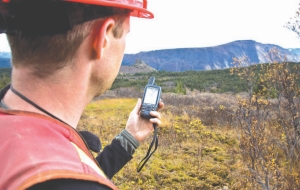VANCOUVER — Imperial Metals’ (III-T) deep drilling program at the Red Chris copper-gold project in northwest British Columbia continues to produce long mineralized intercepts below and beside the planned pit as the company advances development plans for the large porphyry deposit.
Hole 353 produced one of the longest mineralized intercepts to date at Red Chris, returning 1,135 metres grading 0.5% copper, 0.59 gram gold per tonne and 0.01% molybdenum. A 450-metre segment in the lower half carried 0.8% copper and 1.07 grams gold.
The interval, which started at just 68 metres downhole, is also notable as the first hole at the project to hit a continuous interval of molybdenum mineralization: the 145-metre interval starting at 1,032 metres depth averaged 0.029% moly.
That long intercept came from a collar 220 metres northeast of hole 335, the deep mineralization discovery hole that returned 1,024 metres grading 1.01% copper and 1.26 grams gold. Hole 353 is also now the most northeasterly hole to date in the deep zone.
Collared 26 metres southwest of hole 335, hole 354 hit strong mineralization early. A 297.4-metre interval starting 7 metres below surface carried 1.77% copper and 1.69 grams gold. Later, at 480 metres depth, the hole cut a lengthy 817.5 metres grading 0.55% copper and 0.47 gram gold. Hole 354 actually deviated significantly to the south during drilling and failed to test the intended horizon. Regardless, the hole successfully indicated continuity of mineralization between hole 335 and hole 350, which in late 2009 returned 647.5 metres grading 1.5% copper and 2.68 grams gold, including 152 metres averaging 4.12% copper and 8.83 grams gold.
Moving 440 metres west of hole 335 in a significant step-out to the west, hole 355 encountered 757 metres grading 0.38% copper and 0.48 gram gold starting at 335 metres depth. The result indicates continuity of mineralization between the Main zone and the East zone below the depth previously tested.
And hole 360, collared 60 metres west of hole 350, returned a mineralized intercept with similar characteristics to its neighbour. The drill hit 528.7 metres grading 1.13% copper and 1.97 grams gold from 474 metres depth. Assays for the last 265 metres of core from hole 360, which reached 1,268 metres depth, are not yet available.
Imperial’s 2010 program at Red Chris is designed to delineate the Red Chris system to at least 1,000 metres below surface, with some holes probing to 1,500 metres. The early holes in the program tested below the planned pit; drills are now testing for lateral depth expansion.
Red Chris is a large deposit in northwest B.C., 80 km south of Dease Lake. A 2005 feasibility study estimated the project’s proven and probable reserves at 276 million tonnes grading 0.349% copper and 0.266 gram gold per tonne, enough to support a 30,000-tonne-per-day operation for 25 years. The planned pit would be 1.8 km long and up to 1 km wide, covering both the Main and East zones.
Drilling has expanded both of those zones significantly in the last four years, but Imperial has not updated the project’s resource estimate or feasibility numbers since hitting environmental assessment stumbling blocks in 2006. The company submitted a project description to the B.C. Environmental Assessment Office in 2003 and, following a two-year process that included public consultation, was awarded a provincial environmental assessment certificate in 2005.
In mid-2006, a federal screening process concluded Red Chris was not likely to cause significant adverse environmental effects and the responsible authorities decided the project could proceed. Mining Watch Canada challenged the federal decision, arguing the federal government did not have the authority to assess a project using only a screening level review instead of using a comprehensive process.
The legal battle stretched for more than three years, with a final decision reached in January. In its decision the Federal Supreme Court decided the government indeed does not have the authority to re-scope projects in that manner but, given the lack of environmental issues with respect to Red Chris and given that Imperial acted in good faith throughout the flawed process, awarded Imperial an exemption to the ruling. The end result is that Imperial now holds valid provincial and federal environmental assessments for Red Chris, which has prompted the company to revitalize its efforts at the site.
Imperial also operates the Mount Polley copper-gold-silver mine in central B.C. as well as the nearby Huckleberry copper-gold-silver-molybdenum mine, in which it owns a 50% stake.
Imperial’s share price gained $1.47 on news of the latest Red Chris drill results to reach $20.95, a new 52-week high. A year ago, Imperial shares were trading as low as $3.21. Imperial has 36 million shares outstanding.
———
Notes from a geologist’s field book
R.H. Seraphim, a geologist and long-time Norther Miner subscriber, visited the Red Chris area in July 1970 with William “Bill” St. Clair Dunn of Silver Standard. Mr. Seraphim recently shared with us his notes from that visit, which are reproduced below:
Bill and I visited the gossan. No bedrock was exposed. But a small turbulent stream drained northerly toward Falue Lake. We left the helicopter, hiked down the stream, and found an outcrop. It had strong shearing trending about N 60 E. The more or less square block of Great Plains claims led us to deduce the claims had been staked with no knowledge of the trend of the mineralization.
We hiked back to the helicopter and headed east over the relatively flat upland. It had abundant low vegetation and no outcrop. We saw a gossan a couple of miles to the northeast. It was definite enough for us to decide to stake the intervening ground.
A bulldozer was available in the area. It was used to trench the prospective newly claimed area easterly from Great Plains. I was very amused and delighted to see bright orange gossan show up underneath several feet of black muck.


Be the first to comment on "Imperial rises on more long intercepts at Red Chris (April 26, 2010)"